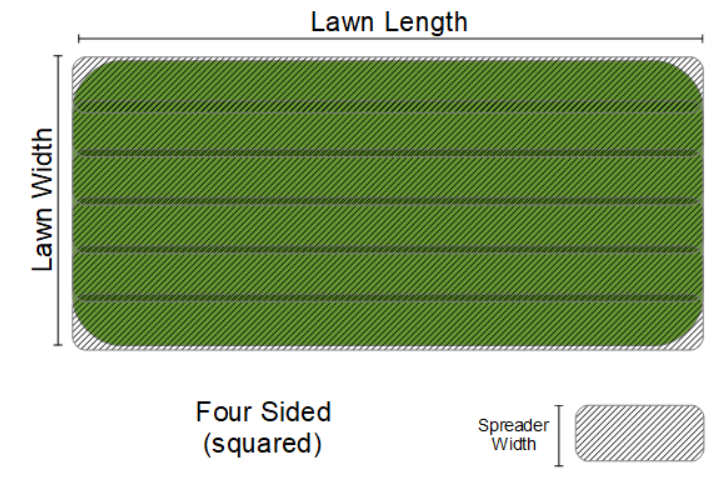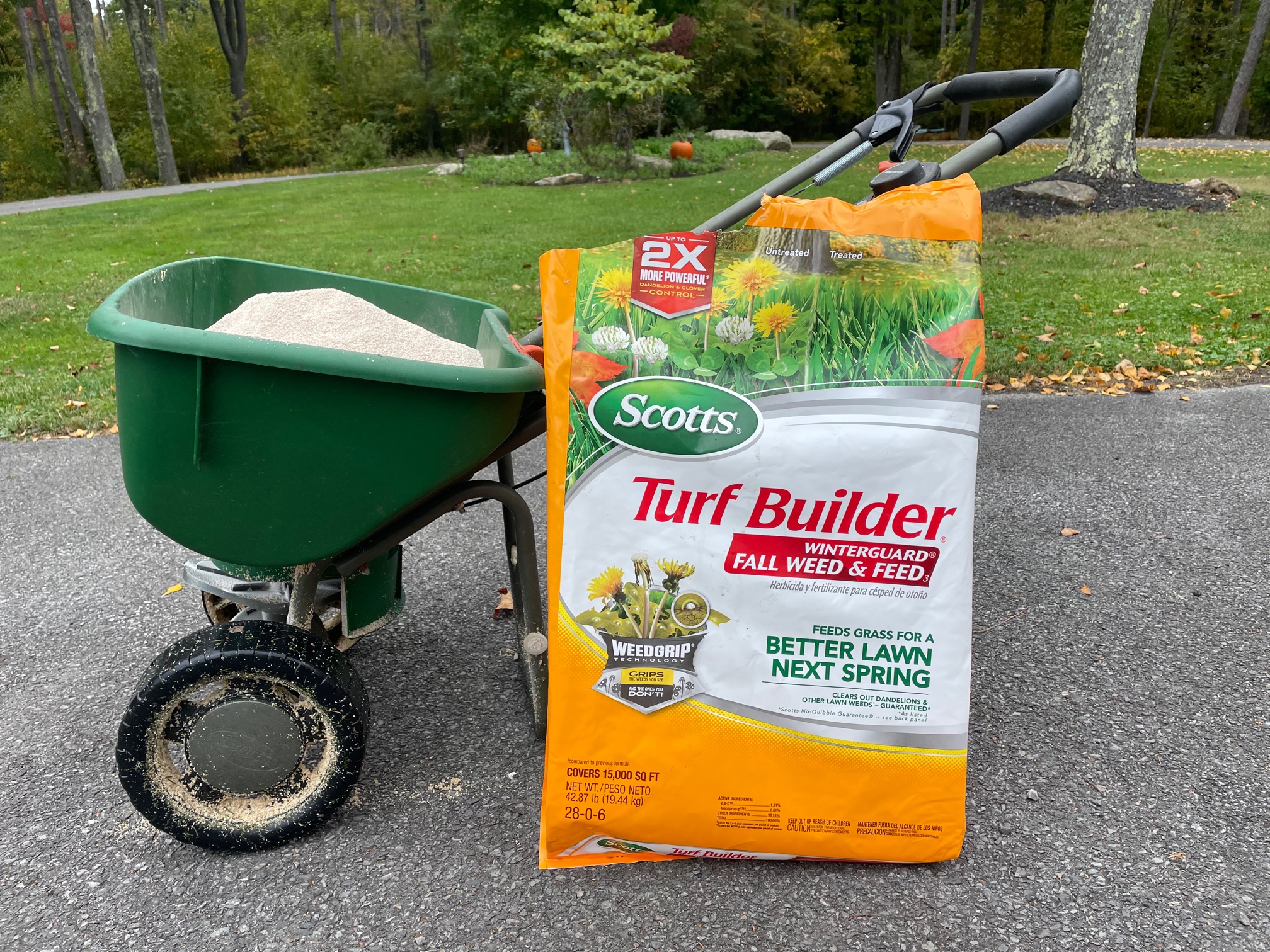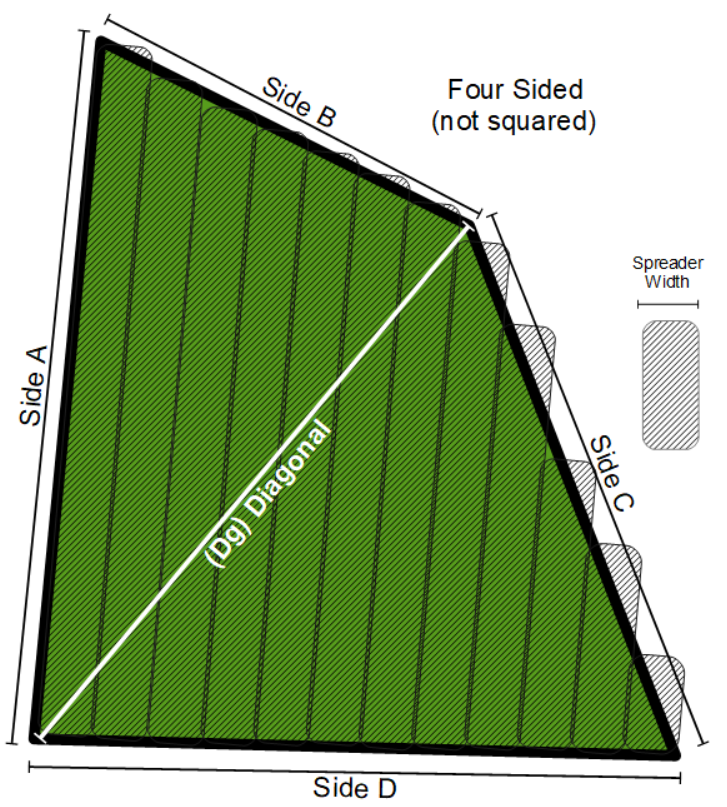The Lawn Spreader on an Area calculator computes the number of bags of lawn treatment (grass seed, weed killer, lawn fertilizer) that are needed for a lawn based on the manufacturer recommended area of coverage per bag and the size (area) of the lawn.
INSTRUCTIONS: Choose area units and enter the following:
- (A) Lawn Area
- (BC) Coverage per Bag
How Many Bags (nB): The calculator returns the number of bags needed to treat the lawn when using a spreader at the proper setting..
The Math / Science
Lawns require seed and then regular treatment to have thick grass with few or no weeds.
Lawn Care Product Coverage
The following table is for reference only and based on the manufacturer's published product coverage information. Please recommend additions or corrections.
| Lawn Care Product | Bag Size | Coverage |
|---|---|---|
| Scotts Turf Builder (Halts CRABGRASS PREVENTEER) | 13.35 lb | 5,000 ft2 |
| Scotts Turf Builder (Triple Action 1) | 11.31 lb | 4,000 ft2 |
| Scotts Turf Builder (Fall) | 11.43 lb | 4,000 ft2 |
| Scotts Turf Builder (Winterguard Fall Lawn Food) | 37.5 lb | 15,000 ft2 |
| Scotts Turf Builder Sun & Shade Mix Grass Seed | 20 lb | 8,000 ft2 |
| Pennington Contractor Mix Grass Seed | 40 lb | 3,300 ft2 |
| PLEASE RECOMMEND OTHERS! | TBD | TBD |
The treatments for lawns often come in the form of bags of treatment (seed, weed killer, fertilizer) from the home improvement store (e.g. Lowe's). The common practice for the manufactures is to list the square feet covered by the application of one bag. This calculator will tell you how many bags you need.
The formula for the number of bags of lawn treatment needed is:
nB = A / BC
where:
- nB = Number of Bags of Lawn Treatment needed
- A = Area (square footage of yard)
- BC = Bag Coverage (how many square feet per bag)
How big is your yard?
If you know the dimensions of the lawn, you can enter them in one of the calculators listed here to compute the square footage of the lawn.
Using Google Maps to Measure Your Lawn
One great tool for measuring the size on a yard is Google Maps. Find your home, and then right click on the screen. The last option is "Measure Distance". If you use this, to outline your yard, you will also get the square feet within the outline in an info box (see image of our yard). Our yard, indicated 110,138 ft2 . If we want to treat it with, the Fall Lawn Food (above) that covers 15,000 ft2 per bag, we enter 110138 ft2 (A) in the calculator and 15,000 ft2 (BC) in the calculator to find that we need 7.3 bags. So I'll buy 8 to be safe.
Lawn Spreader Calculators
The Lawn Spread Calculator helps you determin how many bags of product you need. Spreaders are often used for grass seed, weed and feed, lime and lawn fertilizers. Choose the shape of the lawn from the list below or just use the Lawn Spreader Area if you know the acres, square feet, yards or meters. Then enter the specifications of your lawn, and the area covered by one bag of product. The calculator returns how many bags you need.
- Lawn Spreader Rectangle: Computes the number of bags of lawn treatment needed for a rectangular lawn based on the manufacturer recommended area of coverage per bag and the length and width of the lawn.
- Lawn Spreader on an Area: Computes the number of bags of lawn treatment (grass seed, weed killer, lawn fertilizer) are needed for a lawn based on the manufacturer recommended area of coverage per bag and the area (square feet, acres, square yards or meters) of the lawn.

- Lawn Spreader Triangle: Computes the number of bags of lawn treatment needed for a triangular lawn based on the manufacturer recommended area of coverage per bag and the length of the three sides of the lawn.
- Lawn Spreader 4 Sided (non-Square): Computes the number of bags of lawn treatment (grass seed, weed killer, lawn fertilizer) needed for a four sided lawn based on the manufacturer recommended area of coverage per bag and the length of the four sides and diagonal of the lawn.
- Lawn Spreader 5 Sided:: Computes the number of bags of lawn treatment (grass seed, weed killer, lawn fertilizer) needed for a five sided lawn based on the manufacturer recommended area of coverage per bag and the length of the five sides and two diagonals of the lawn.
Land Size Calculators
Three Sided Land Size: Computes the square feet, acres and perimeter in land with three straight sides.
- Four Sided Land Size (squared): Computes the area in square feet and acres and perimeter in feet of rectangle land with roughly squared corners based on the length and width.
- Four Sided Land Size (not squared): Computes the area and perimeter of four sided land based on side lengths and a length of a diagonal.
- Five Sided Land Size: Computes the area and perimeter of a five sided land based on side lengths and the lengths of two diagonals.
- Circular Land Size: Computes the area of land in roughly circular shape based on the width (diameter).
- Simi-Circular Land Size: Computes the area of land in roughly semi-circular shape based on the width (diameter).
- Oval Shaped Land Size: Computes the area of land in roughly an oval (ellipse) shape based on the length and width.
- Human Paces to Feet and Meters: Estimates a length (feet, yards and meters) based on the number of paces a person takes to walk it and the approximate length of stride.
Walking Measurements
For large areas (lawns, gardens or fields), it may be hard to measure longer lengths, because you have no measuring device to make the long measurements (electronic device or long measuring tape or twine). In this case, an estimate can be achieved by using paces (your steps).
To estimate a length with paces, you first have to make a reasonable estimate of a regular pace while in stride. To do this, put a mark on the ground, and step back several paces. Start walking to the mark, and start counting some number of paces past the mark (e.g. 10). A that point, stop and measure the length. For example a man of six feet tall with a normal stride walked 14 paces in 40 feet. That gave him a feet per pace of 2.857 feet per pace. To compute the Feet per Pace, CLICK HERE. You can then walk off the measurements, using a steady pace, and convert the Paces to Feet by CLICKING HERE. It's a rough estimation method, but not without it's uses.
Often it is required to put land pieces together to compute to total area of land. The land shown can be accurately computed by individual triangles. The area of 5 sided land function requires the diagonals that create three triangles that are summed to compute the area in a 5 sided piece of land.
Lawn Care Calculators
Mowing Calculator: Estimates the distance walked, area covered, calories burned mowing and time required to mow an area of grass based on mower cutting deck width, speed and whether its a push mower or riding mower.
- Mowing Triangle: Mowing a triangle shaped area.
- Mowing Rectangle: Mowing a rectangle shaped area.
- Mowing 4 Sided non-Squared: Mowing a four sided area that does not have square corners.
- Mowing 5 Sided: Mowing a five sided area.
- Calories Burned Mowing Grass: Estimates the calories burned mowing (push or riding) based on person's weight and time spent mowing grass.
- Lawn Spreader Calculator: Functions to estimate the number of bags of lawn product (grass seed, weed killer, lawn fertilizer, lime) are need to for different shaped lawns (below).
- Lawn Spreader on an Area: Computes the number of bags of lawn treatment (grass seed, weed killer, lawn fertilizer) are needed for a lawn based on the manufacturer recommended area of coverage per bag and the area of the lawn.
- Lawn Spreader Triangle: Computes the number of bags of lawn treatment needed for a triangular lawn based on the manufacturer recommended area of coverage per bag and the length of the three sides of the lawn.
- Lawn Spreader Rectangle: Computes the number of bags of lawn treatment needed for a rectangular lawn based on the manufacturer recommended area of coverage per bag and the length and width of the lawn.
- Lawn Spreader 4 Sided (non-Square): Computes the number of bags of lawn treatment (grass seed, weed killer, lawn fertilizer) needed for a four sided lawn based on the manufacturer recommended area of coverage per bag and the length of the four sides and diagonal of the lawn.
- Lawn Spreader 5 Sided:: Computes the number of bags of lawn treatment (grass seed, weed killer, lawn fertilizer) needed for a five sided lawn based on the manufacturer recommended area of coverage per bag and the length of the five sides and two diagonals of the lawn.
- Grass Seed Calculations use SPREADER calculators above with the grass seed specifications from the manufactures.
- New Sod Calculator: Computes the number of sod pieces needed for an area based on the size of the pieces of sod.
 New Sod Triangle: Computes the number of pieces of sod needed to cover a triangular shaped area such as a yard or field.
New Sod Triangle: Computes the number of pieces of sod needed to cover a triangular shaped area such as a yard or field.- New Sod Rectangle: Computes the number of pieces of sod needed to cover a rectangular shaped area such as a yard or field.
- New Sod 4 Sided: Computes the number of pieces of sod needed to cover a four sided (not squared) shaped area such as a yard or field.
- New Sod 5 Sided: Computes the number of pieces of sod needed to cover a five sided shaped lawn area such as a yard or field.
- New Sod Circle: Computes the number of sod pieces required to cover the given diameter of a circle.
- New Sod Oval: Computes the number of sod pieces required to cover an oval. It also provides the oval area and perimeter.
- Straw Cover Area Calculator: Computes the number of regular square-bales of straw needed to cover an area such as a field or garden for new grass seed. The common bales are 2 string square bales of 14"x18"x"36" inches weighing between 40lbs and 60 lbs.
- Bales of Straw over Rectangle: compute the number of regular square-bales of straw needed to cover new seed on a rectangle area (length by width). .
- Market Price for Bales of Straw: Returns recent market survey on the price of straw bales.

